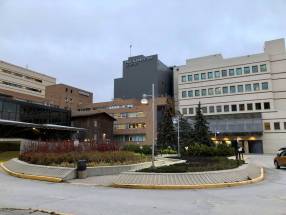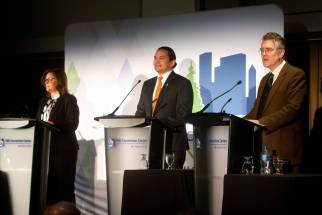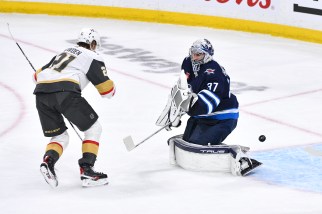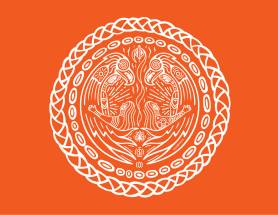New era in downtown’s rebirth Jets ‘whiteout’ shows vitality and optimism about city’s core
Read this article for free:
or
Already have an account? Log in here »
To continue reading, please subscribe:
Monthly Digital Subscription
$0 for the first 4 weeks*
- Enjoy unlimited reading on winnipegfreepress.com
- Read the E-Edition, our digital replica newspaper
- Access News Break, our award-winning app
- Play interactive puzzles
*No charge for 4 weeks then price increases to the regular rate of $19.00 plus GST every four weeks. Offer available to new and qualified returning subscribers only. Cancel any time.
Monthly Digital Subscription
$4.75/week*
- Enjoy unlimited reading on winnipegfreepress.com
- Read the E-Edition, our digital replica newspaper
- Access News Break, our award-winning app
- Play interactive puzzles
*Billed as $19 plus GST every four weeks. Cancel any time.
To continue reading, please subscribe:
Add Free Press access to your Brandon Sun subscription for only an additional
$1 for the first 4 weeks*
*Your next subscription payment will increase by $1.00 and you will be charged $16.99 plus GST for four weeks. After four weeks, your payment will increase to $23.99 plus GST every four weeks.
Read unlimited articles for free today:
or
Already have an account? Log in here »
Hey there, time traveller!
This article was published 23/04/2023 (966 days ago), so information in it may no longer be current.
White hair — mostly natural. White wigs — probably synthetic. White shoes — exceedingly high-heeled. White jerseys — personalized. White knuckles, gripping their pints of lager, anxiously awaiting puck drop before Game 3 between the Winnipeg Jets and the Vegas Golden Knights.
Each person populating the pallid pallet was eager to see a Jets win. But it’s safe to say nobody at True North Square had more invested in the day’s results than Mark Chipman, who strode through the crowd wearing a blue suit, spotless glasses, and an immutable, inscrutable focus.
In 2011, Chipman became the subject of everlasting Winnipeg folklore when he announced the impossible: 15 years after the NHL franchise was sold and relocated to Phoenix, the Jets were coming back to where they belonged. The US$170-million deal, which brought the former Atlanta Thrashers north of the border, was the culmination of a plan which first felt real in 2004, when the arena now called Canada Life Centre opened its doors on the site of the former Eaton’s flagship store on Portage Avenue.
Chipman’s and David Thomson’s purchase of the franchise, now worth an estimated US$650 million, was likely the most significant business deal in modern Winnipeg history.
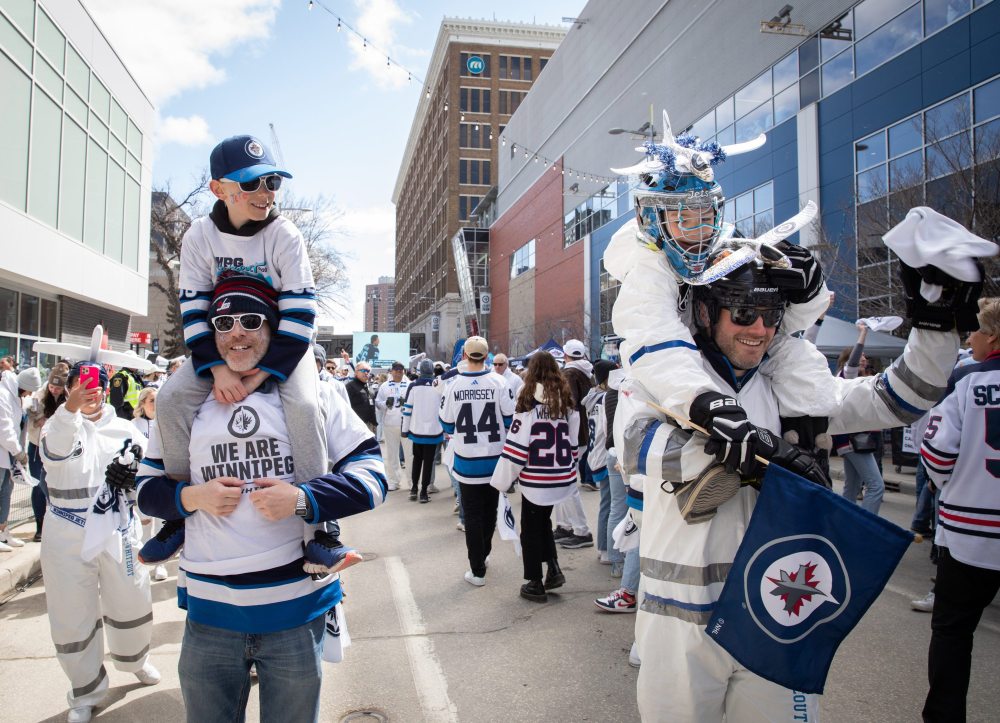
But the Jets’ return was only one component of a grand, overarching plan, perhaps the only one more difficult to complete than delivering to the city of Winnipeg its first Stanley Cup: the revitalization of downtown.
It’s a lot to ask of a professional hockey club to save an urban core, or as Jets fan Gary Turnbull phrased it Saturday, to “put a little bit more jam in the donut.” Chipman and True North Sports and Entertainment have desperately tried to do that: the feeling in the city, circa 2011, was one of optimism and possibility: if the Jets could come back, wasn’t anything possible?
Over the ensuing 12 years, the franchise’s on-ice results have been mixed: the team has made the playoffs five times, while only finishing below .500 once. Meanwhile, the grid surrounding the arena has experienced expansion and attrition simultaneously. The first-phase developments and public plaza component of True North Square — the most expensive mixed-use real estate development in Winnipeg’s history — opened in September 2018, beginning an ongoing urban revision with the Jets at its heart. Then, of course, a year and a half later, the COVID-19 pandemic struck the downtown hard, leading to business closures, economic inflation, and an exacerbation of the public crises — affordable housing, poverty, and mental health access — which have long been felt with the most intensity in the heart of the city.
Meanwhile, the Jets struggled to sell out games this season, a far-cry from the inaugural campaigns when a seat at the arena was harder to find than a street without a pothole.
The sociologist Emile Durkheim used the term collective effervescence to refer to that somewhat indescribable sensation of unified passion and engagement felt by a large, disparate group participating in a shared experience. He was referring to religious rituals, but the term could reasonably be applied to the air in True North Square on Saturday: in an era when religiosity is lower than ever, the value of professional sports teams has never been higher.
In 2018, the last time the Jets made their march into the postseason to face the Knights, who defeated Winnipeg 4-1 in the best-of-seven Western Conference Final, none of this was here: the Square, the swanky Hargrave Street Market, and any notion of the pandemic, which flattened any effervescence into a distant memory.
“I hadn’t really considered the fact that we didn’t have any of this last time,” Chipman said, about 90 minutes before the opening faceoff. That notion left him, like the rest of the fans in the building, trying to wrestle with lost time.
“Does this White Out feel different?” he repeated the reporter’s question before answering. “A little, because it’s been a while. The pandemic took us through two playoffs without being able to host anybody, and now” — he gestured around the packed market — “there are thousands. So, maybe there’s more anticipation, but they all feel good. It’s just overwhelming. To see this. To feel this.
“I think it just confirms that downtown is a great place to gather, and I’d like to see it happen more often,” he continued. “We’ve made lots of headway, and we really have to continue to take care of the people who are vulnerable and struggling, which is a big focus for us.”
“I think it just confirms that downtown is a great place to gather, and I’d like to see it happen more often.”–Mark Chipman
In November, Chipman, who chairs the non-profit Downtown Community Safety Partnership, said the ongoing social struggles — homelessness and addiction — downtown were a “humanitarian crisis.” “It’s hard to walk a block without seeing someone who is suffering,” he said. At the time, Chipman reasserted that the construction of a downtown arena was never expected to be “a panacea for all that ails downtown.”
But maybe, Chipman suggested Saturday, this playoff run could be the start of a new era in downtown’s rebirth, bringing back people who hadn’t been there for years.
Chipman didn’t have much more time to mingle, however.
He, like everyone else, was ready to watch playoff hockey.
Ethan Alexander didn’t have tickets to the game, but he did have one of the best seats. The 12-year-old was plunked in a folding chair in front of a giant screen just north of the Millennium Library, sitting with his sister, mom, and grandmother on Donald Street, where F150s normally idle and city buses usually swoop by during the afternoon rush.
Thousands of pedestrians filled the streets for the Whiteout party, a modern outdoor celebration steeped in Jets 1.0 tradition.
Excellent outfits abounded: Ron McLennan, a city parking employee, donned a bloodless butcher’s coat. Shane Luff, 21, of Selkirk, wore a white painters’ suit covered with individually sewn strips of white garbage bags, looking like a yeti crossed with a pom-pom. Stephanie, Erik and Pierre Dupuis wore flight suits and helmets topped by skyward jetplanes; they posed for pictures all day long. Mark Peters, of Steinbach, wore a Budweiser red-light hockey helmet while sipping a beverage from the Lake of the Woods Brewing Company.
Chief Kevin Redsky and Harmony Redsky of Shoal Lake 40 First Nation wore white bathrobes and Dollarama moustaches. Shay-Lee Bolton, an assistant professor of psychiatry at the University of Manitoba, was dressed in fleece as white as snow in a homemade Serta sheep costume, carrying in her hand a sign reading, “Nighty night Knights.”
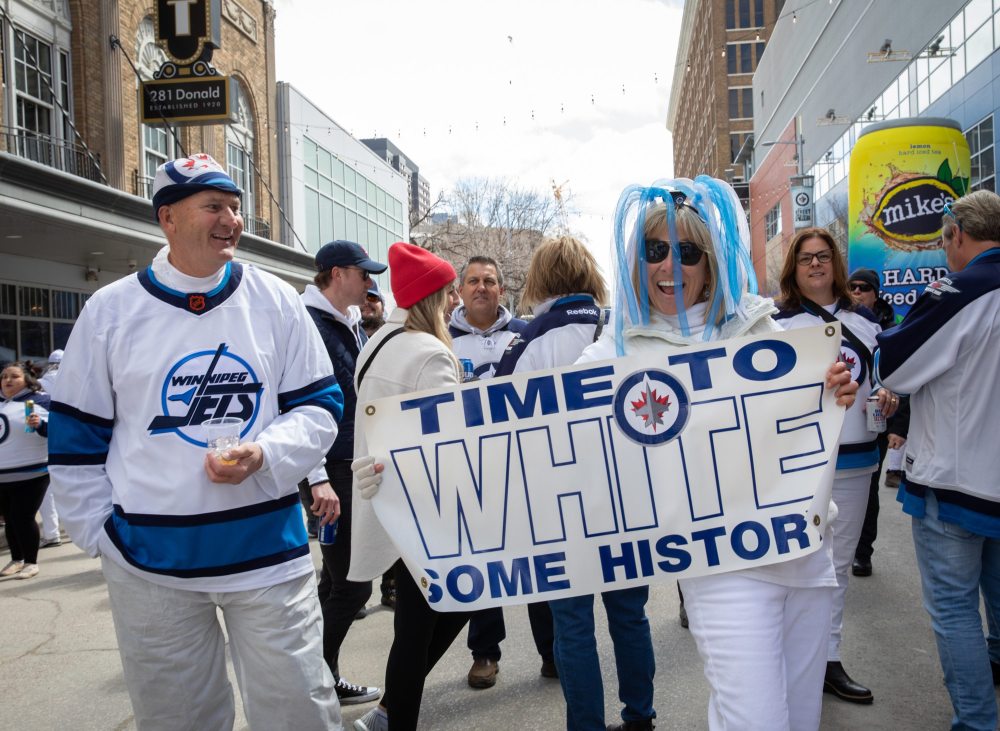
Josh Waldman, of no relation to this reporter, said the Whiteout was “the best thing since sliced bread.”
Downtown looked different, agreed Douglas Koval, Sally Rose and Laurie Sapischuk, who should know: a paralegal at Thompson Dorfman Sweatman, Sapischuk’s 16th floor office overlooks the expanse of True North Square, where on Saturday, grown men dressed like lambs and toddlers dressed like stormtroopers stood in line for popcorn. “The energy is totally different,” she said.
Standing beside a statue of Hall of Famer Dale Hawerchuk, overtop of what might have already been a set of luscious locks, Jack Partridge wore milky, frilly curls. “It’s natural,” he insisted. Partridge and Donna Baschuk, who also wore a luxe wig of white, said the mood downtown felt like the first time the Jets made the playoffs after their return to the city in 2011. How to summon this energy more often? Partridge has a solution.
“Have playoff hockey every day,” he said, straight-faced. If only. But to win the Cup, a team can play a maximum of 28 games, and that’s if each series goes to seven games.
First, the Jets have to get out of the opening round.
Hunter Allan Overby doesn’t have the best luck.
“I’ve been to four or five Whiteout games, and they’ve never won,” said the 21-year-old aspiring science teacher. “Today’s the day though.”
It only took two minutes and 52 seconds before Overby’s vibe shifted: when Vegas centre Chandler Stephenson beat Jets goaltender Connor Hellebuyck for the first goal, Overby and his friend Julia Daniels unleashed a few words to the heavens that can’t be printed.
Nearby, a man drinking whiskey from a plastic flask took issue. “Boys, no need for all this negativity,” he said. When it was announced that defenseman Josh Morrissey would not return after suffering a lower-body injury, his optimism faded too.
JESSICA LEE / WINNIPEG FREE PRESS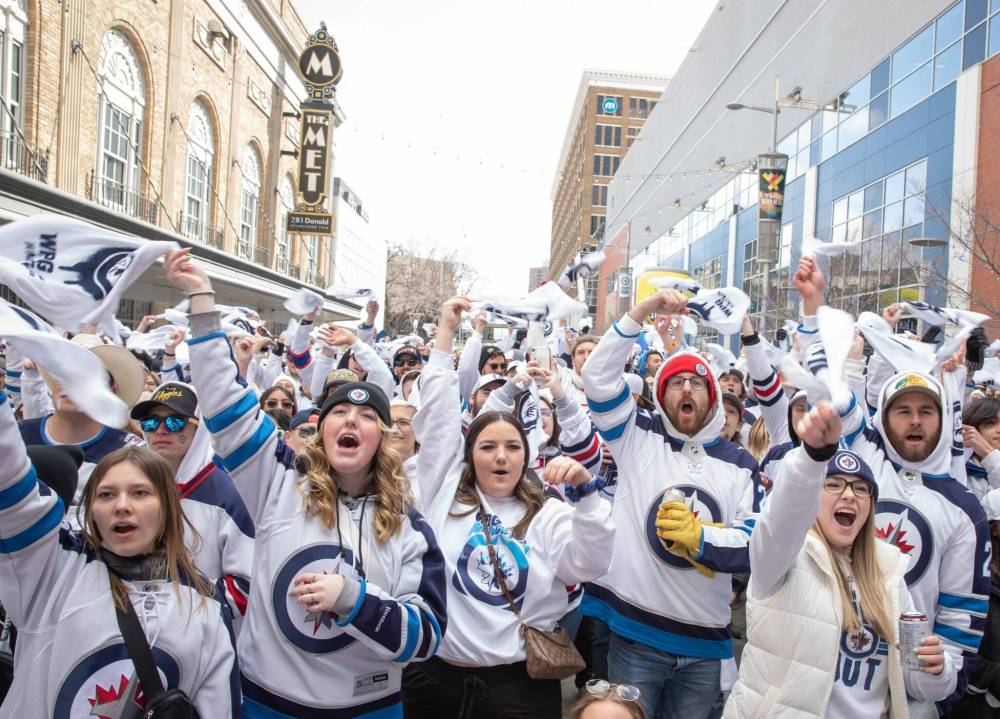
These are the types of emotions that come up during a hockey game for fanatics: overwhelming hope, permeated by existential dread. The last time the Jets made the playoffs, in the 2020-2021 season, pandemic lockdown measures were still enforced to promote public safety. So, when Winnipeg lost to the Montreal Canadiens, fans had to scream alone, or at least, within their bubble.
Not Saturday, during what was one of the most entertaining playoff games in Jets history.
The match didn’t seem to be headed toward classic status to begin the third period when Vegas led 4-1. Ethan Alexander, now standing to the side, chewed his fingernails; a man whose face was painted white took on an even more ghastly complexion, and he stormed off in disgust.
But then Winnipeg scored, then scored again, narrowing the deficit to one. Suddenly, the prediction — 5-4 — of a tipsy man wearing a teal corduroy Jets hat was alive.
And then with 22 seconds left in regulation, Adam Lowry jammed the puck behind old friend Laurent Brossoit to send the game to overtime, and Donald Street shook. In front of the screen, a man passionately dipped a woman and the couple shared a 15-second-long smooch and loving embrace.
Only they weren’t a couple.
“I’ve never met this woman in my life!” shouted Owen Gregora, who started dancing with a group of strangers as Sweet Caroline was piped over the sound system.

About an hour later, in the second overtime period, the Golden Knights’ Michael Amadio scored the game-winning goal, continuing Overby’s unfortunate streak of luck and giving Vegas a 2-1 lead in the best-of-seven series.
The on-ice result was not what the home crowd wanted. But it’s difficult to argue with Jets head coach Rick Bowness’ post-game assessment. “That was a hell of a hockey game,” he said.
After Amadio’s heartbreaker, the crowd of an estimated 10,000 fans, split between two sold-out parties on Donald Street and the outdoor plaza at True North Square, dispersed. Inside the arena, 15,000 more made their way for the exits, pouring into taxi-cabs, Ubers, and downtown bars to wallow in their disappointment.
On Monday, when Game 4 happens, another group of 25,000 will reconvene downtown, dressed in white.
But who will return when the party’s over and the music stops playing?
ben.waldman@winnipegfreepress.com

Ben Waldman is a National Newspaper Award-nominated reporter on the Arts & Life desk at the Free Press. Born and raised in Winnipeg, Ben completed three internships with the Free Press while earning his degree at Ryerson University’s (now Toronto Metropolitan University’s) School of Journalism before joining the newsroom full-time in 2019. Read more about Ben.
Every piece of reporting Ben produces is reviewed by an editing team before it is posted online or published in print — part of the Free Press‘s tradition, since 1872, of producing reliable independent journalism. Read more about Free Press’s history and mandate, and learn how our newsroom operates.
Our newsroom depends on a growing audience of readers to power our journalism. If you are not a paid reader, please consider becoming a subscriber.
Our newsroom depends on its audience of readers to power our journalism. Thank you for your support.













